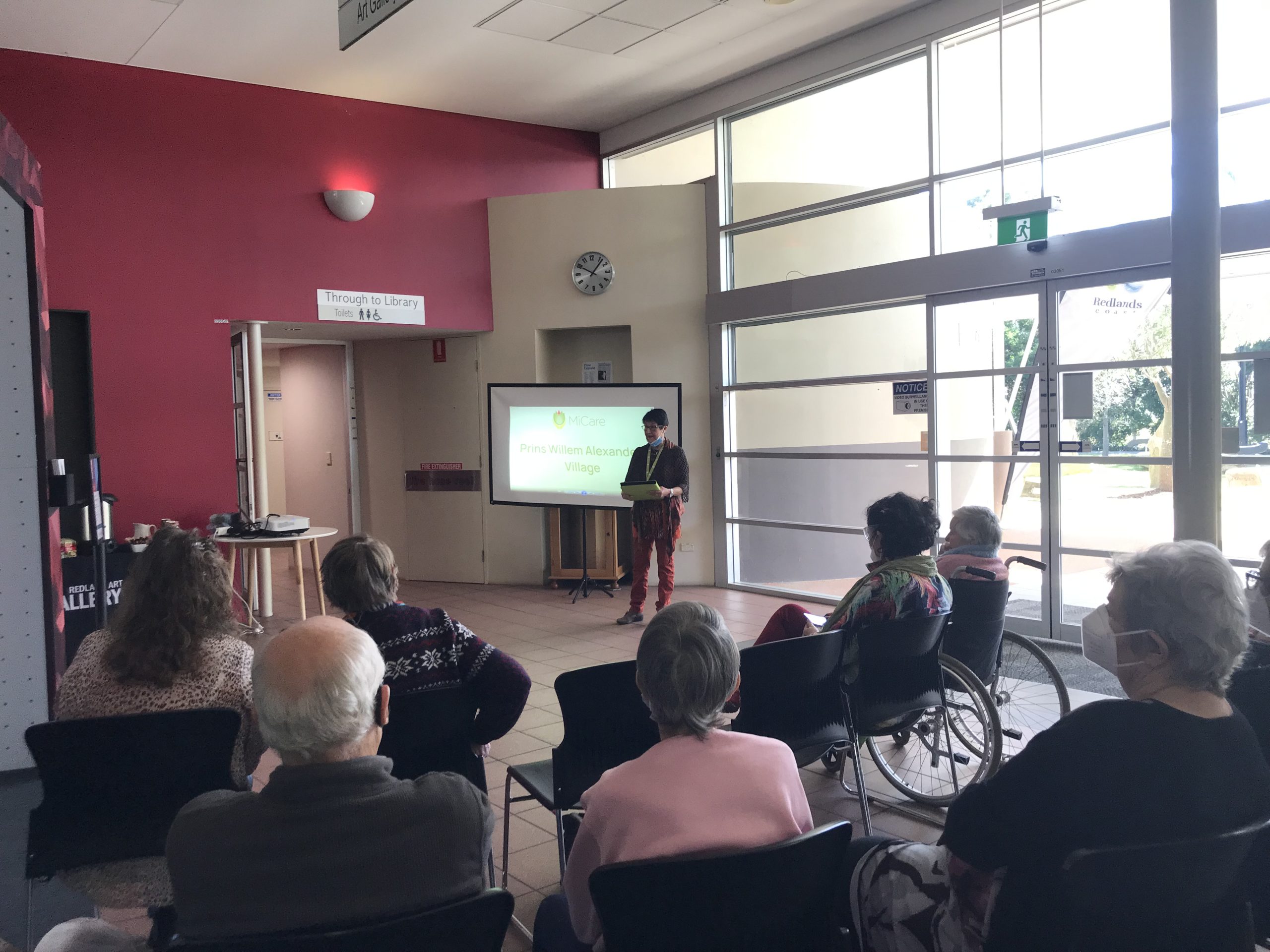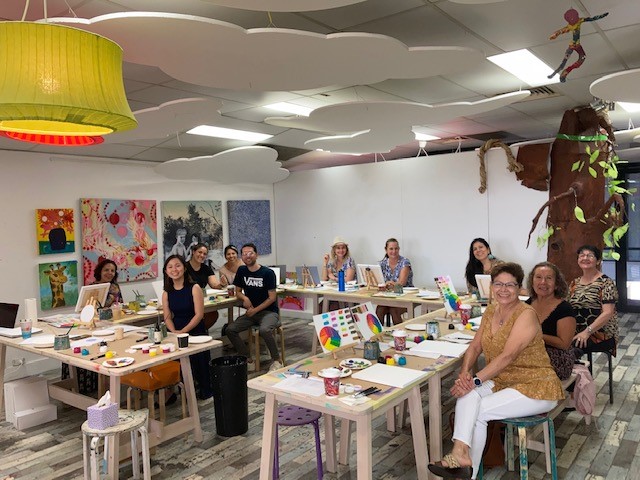Project name: Finishing Touches: My Artistic Golden Brooch
Project Sponsor: MiCare Ltd., Regional Arts Development Fund, PFD Food Services PTY Ltd. Plena Health Care, and SSS Australia.
Project Cost: $ 10.900 ($5,350 financial funding and donations, + $ 5,550 organisational in kind)
Project Manager: Mercedes Sepulveda
Start Date: November 2020
Completion Date: July 2022
Purpose of the Project
The aim of this project was to engage Elders at PWAL in a unique therapeutic art experience by creating a meaningful painting. The objectives of the project were:
- To facilitate a meaningful artistic program for Elders at a residential community level.
- To engage Elders from a diverse cultural backgrounds to create a My Artistic Golden Brooch
- To provide a supportive, non-critical environment, where Elders could communicate and showcase their creations regardless of their abilities, and cultural and linguistic heritage through art.
- To engage the expertise of a local certified art therapist to mentor staff, volunteers, and family members.
- To provide opportunities to the public to honor seniors for their creations and accomplishment to celebrate a sense of difference and highlight the richness of the culturally diverse Elders’ population through a unique art experience in the Redland community.
Background
This project acknowledges that art is one of the most popular and successful activities and therapies in residential aged care. The act of producing art can be an important, meaningful, and enjoyable experience, that focuses the participant away from daily concerns while the Elder becomes immersed in the creative process. However, as this art practice generally occurs in a group setting in residential aged care, where individual Elders have varying levels of physical and mental capacities, the group instructions are often rendered ineffective for individuals who are impaired by cognitive, memory, language, and/or other impairments.
In this project, participants worked independently, they received personalized individual support during the whole painting process at their pace. Each Elder was allocated a volunteer who was able to support them while engaging in the painting process.
It was recognized that some staff and volunteers have existing experience in supporting creative activities for Elders at a community group level, without receiving special training to do so. Our project engaged the expertise of a professional art therapist during an experiential workshop to guide, share knowledge and impart skills to staff and volunteers supporting the Elders individually on a one-on-one level. This significantly contributed to Elders participating successfully in the art project. They each received individual emotional, communication, and technical support, even enabling Elders who were unable to speak or write to communicate on an intuitive level with satisfaction.
Project Logistics and Completion
The project was run with a steering committee, which was composed of the PWAL Deputy manager representing the staff and management team, representatives from the Lifestyle Team, and the Volunteer Service Team, and it was chaired by the Project Manager. Initially, the committee met once a month, and then every two months. Executing the project, planning actions, and organising the official exhibition at the Redlands Art Gallery in Capalaba were other important tasks of the Steering Committee.
This art project was planned to run for 12 months, starting in October 2020, and finalizing in October 2021. However, due to the COVID-19 restrictions and lockdowns, the project started in November 2020 and was finalized in July 2022.
It was proposed to engage a maximum of 16 and a minimum of 12 Elders residing in PWAL from culturally diverse backgrounds. Initially, 20 Elders were engaged and 20 volunteers were however, due to illness, withdrawals, and other issues, the project finalized with 14 Elders from 10 different countries of birth, which were Argentina, Australia, Chile, Colombia, Falkland Islands, Ireland, Italy, Spain, the Netherlands, and Uruguay. Languages spoken amongst them were Dutch, English, Italian, and Spanish. The cultural and language backgrounds of staff and volunteers supporting the Elders were Australian, Chilean, Colombian, German, Mexican, South African (Afrikaans), Dutch, Venezuelan, and Vietnamese.
The total number of paintings produced was 17, as 3 participants painted 2 each
While the project was partially funded by the Regional Arts Development Fund ($3,100 only to cover the fees for the local art therapist to run the workshop for the volunteers), to cover the total project cost, the Steering Committee explored potential sponsors with positive outcomes. The financial support was mainly from Prins Willem Alexander’s business suppliers:
- SSS Australia $ 100.00
- PFD Food Services Pty Ltd $1, 250 (Donations by Nestle: $ 500.00 Simplot: $500 and Primo: $250.00)
- Plena Healthcare $ 1,000
With the financial support of the sponsor, purchasing the required painting equipment and materials, travel expenses, and catering it was possible to execute the project successfully.
Engaging Elders and matching them with their respective volunteers was significant work facilitated by the Lifestyle Team. Engaging volunteers in the project was also a significant contribution to completing the project successfully by the PWAL Volunteer Service Team. Dissemination of the project’s information and expression of interest was sent to both groups, Elders, and volunteers. Recruiting, signing consent, and commitment documents were part of the process, as well as informing family members. Regular meetings with volunteers were conducted to facilitate team building, shared learning, provision of support, and debriefing was a crucial part of the process.
To attend the final milestones of the project, the official Art Exhibition, three bus trips, and some individual wheelchair-access taxis for Elders with mobility limitations were organized. Most participants used framed walkers and or wheelchairs. The photographs taken on the occasion very clearly expressed the participant’s joy and happiness to see their piece of art publicly exhibited. Family members and staff attended the exhibition, which was on display for 4 weeks.
This project was inclusive at different levels. Participants included Elders, staff, volunteers, the management team, and Independent Living Unit residents from various ages, gender, and cultures. Some Independent Living Unit residents participated as volunteers for the project, as did facility staff and management team staff who gave their own time. Inclusion of other stakeholders, such as the Redland City Council, PWAL Service suppliers, the Reformed Dutch Church, Redland Art Gallery, the Ethnic Communities Council of Qld. (ECCQ), and Latin American Communities Australia (LACA).
The impact of the painting process on Elders was observed by the participating volunteers and staff and ultimately documented for the participants and family members in both written and pictorial form through a booklet. This was presented to each participant after the official exhibition closed. The content of the booklet includes the process of selecting what to paint, the meaning of the picture, impressions, photos, and dynamics while painting.
Project outcomes
This project benefited Elders, the organisation, and the community in different ways:
- Promoted Elders’ self-awareness about their capabilities and abilities.
- Relieved stress, anxiety, and confusion through a sense of empowerment.
- Contributed to motor and cognitive skills in some participants.
- Helped to cope with a sense of feeling dependent on others by creating a unique artistic masterpiece.
- Facilitated the disclosure of sensitive communication and narratives.
- The Redland community was exposed to the artistic abilities and capabilities of Elders from different cultural backgrounds during the exhibition at the Redland Art Gallery.
- Organisational assets are incremented through staff and volunteers’ capacity building for project sustainability.
Learnings
- The Commitment and trust of MiCare’s management by foreseeing the benefit for the target group and deciding to go ahead with the project irrespective of receiving 29% funding of the total project from the Local Government of Redlands, is one significant highlight of this project.
- As the funding granted by the Regional Arts Development Fund, was specifically for covering the cost fees of the local artist to deliver the workshop to the volunteers, and this was accomplished and acquitted very early during the project’s process, this allows us to manage and address the unforeseen constraints such as lockdowns, and COVID restrictions with even more flexibility and serenity.
- With the flexibility, trust, and commitment of all participants involved during the length of accomplishment, the project is remarkable. Otherwise, this would not have been possible.
- The inclusive, participative, and collaborative methodology applied in running this project were the strengths of the project and developed cultural richness. Different skills, knowledge, and school of thought made this project possible to support Elder’s participants to work individually supported in the masterpiece of art.
- Acquiring a more substantial and essential amount of painting equipment and materials. The number of table easels (20) and stand easels (3) purchased were considered excessive. However, although most participants used table easels when painting, for the exhibition of the paintings the amount was just right. Despite the purchase of varying sizes of canvas many proved not needed as participants mostly used two sizes. Some acrylic paints colors, different sizes of brushes, and pencils were in excess but can be utilized in future artworks.









 Return to News
Return to News




